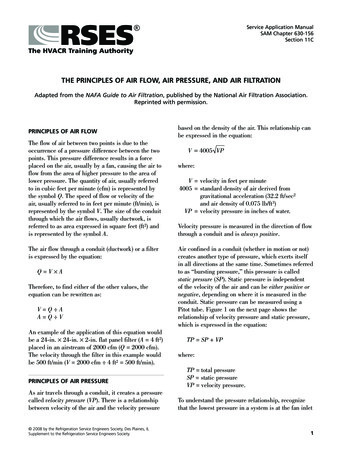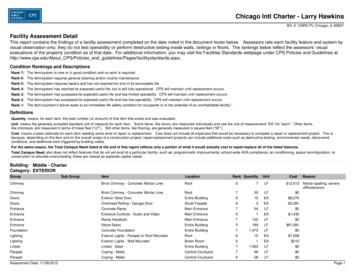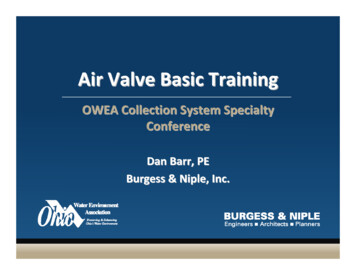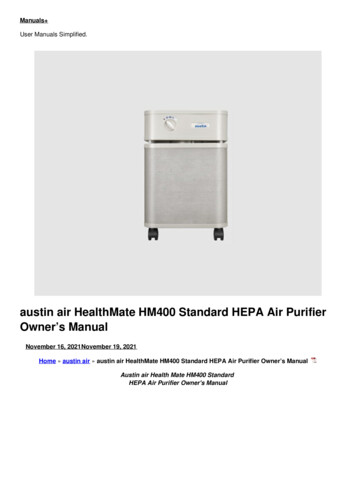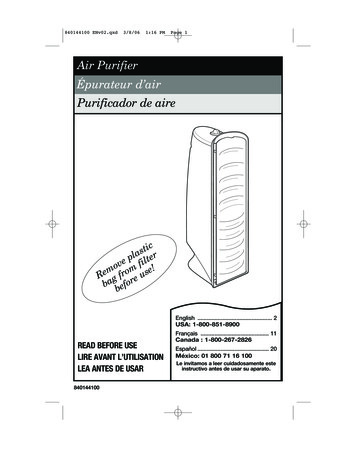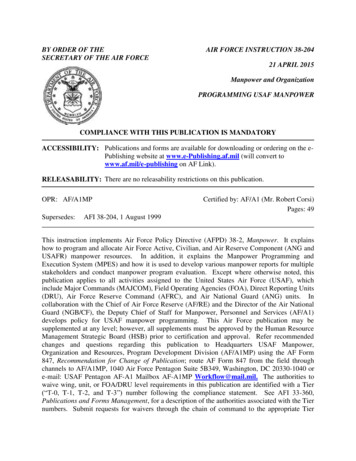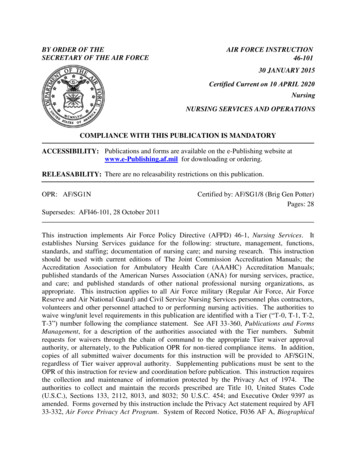
Transcription
BY ORDER OF THESECRETARY OF THE AIR FORCEAIR FORCE INSTRUCTION46-10130 JANUARY 2015Certified Current on 10 APRIL 2020NursingNURSING SERVICES AND OPERATIONSCOMPLIANCE WITH THIS PUBLICATION IS MANDATORYACCESSIBILITY: Publications and forms are available on the e-Publishing website atwww.e-Publishing.af.mil for downloading or ordering.RELEASABILITY: There are no releasability restrictions on this publication.OPR: AF/SG1NCertified by: AF/SG1/8 (Brig Gen Potter)Pages: 28Supersedes: AFI46-101, 28 October 2011This instruction implements Air Force Policy Directive (AFPD) 46-1, Nursing Services. Itestablishes Nursing Services guidance for the following: structure, management, functions,standards, and staffing; documentation of nursing care; and nursing research. This instructionshould be used with current editions of The Joint Commission Accreditation Manuals; theAccreditation Association for Ambulatory Health Care (AAAHC) Accreditation Manuals;published standards of the American Nurses Association (ANA) for nursing services, practice,and care; and published standards of other national professional nursing organizations, asappropriate. This instruction applies to all Air Force military (Regular Air Force, Air ForceReserve and Air National Guard) and Civil Service Nursing Services personnel plus contractors,volunteers and other personnel attached to or performing nursing activities. The authorities towaive wing/unit level requirements in this publication are identified with a Tier (“T-0, T-1, T-2,T-3”) number following the compliance statement. See AFI 33-360, Publications and FormsManagement, for a description of the authorities associated with the Tier numbers. Submitrequests for waivers through the chain of command to the appropriate Tier waiver approvalauthority, or alternately, to the Publication OPR for non-tiered compliance items. In addition,copies of all submitted waiver documents for this instruction will be provided to AF/SG1N,regardless of Tier waiver approval authority. Supplementing publications must be sent to theOPR of this instruction for review and coordination before publication. This instruction requiresthe collection and maintenance of information protected by the Privacy Act of 1974. Theauthorities to collect and maintain the records prescribed are Title 10, United States Code(U.S.C.), Sections 133, 2112, 8013, and 8032; 50 U.S.C. 454; and Executive Order 9397 asamended. Forms governed by this instruction include the Privacy Act statement required by AFI33-332, Air Force Privacy Act Program. System of Record Notice, F036 AF A, Biographical
2AFI46-101 30 JANUARY 2015Data and Automated Personnel Management System and F044 AF SG K Medical ProfessionalStaffing Records apply. The use of the name or mark of any specific manufacturer, commercialproduct, commodity, or service in this publication does not imply endorsement by the Air Force.Refer recommended changes and questions about this publication to the Office of PrimaryResponsibility (OPR) using the AF Form 847, Recommendation for Change of Publication; routeAF 847s from the field through the appropriate functional’ s chain of command. Ensure that allrecords created as a result of processes prescribed in this publication are maintained IAW AirForce Manual (AFMAN) 33-363, Management of Records, and disposed of IAW Air ForceRecords Information Management System (AFRIMS) Records Disposition Schedule (RDS).SUMMARY OF CHANGESThis document has been substantially revised and must be completely reviewed. Major changesinclude deletion of sections 1.4.1.10.3. and 1.4.2.9. (Mentoring), 2.2.2.1.3. and Table 2.1 (P-APNAFSC), 2.2.7. (Civilian Unlicensed Assistant Personnel), 3.6.2.4., 3.6.2.6., & 3.6.2.7.(Medication Preparation), 3.6.2.8. (Medication Administration), 3.6.2.9. (Documentation ofMedication), 3.6.2.10. (Intravenous Therapy), 3.6.2.11. (Dispensing of Medication), 4.4.2. (OBnurses as UTC Substitutions). Sections 1.4, Chapter 2, and 2.2 were retitled to clarify content andredundancy eliminated. 4.2 now defines “Competency” in more detail, and a majority of 4.2 wasremoved and refers to AFI 44-119, Medical Quality Operations where competencydocumentation and specifics about job performance are detailed.Chapter 1—NURSING SERVICES STRUCTURE AND MANAGEMENT OVERVIEW41.1.Nursing Services. .41.2.Organizational Structure. .4Chapter 2—ROLES AND RESPONSIBILITIES52.1.Air Force Total Nursing Force Leadership Roles. .52.2.Oversight of Nursing Services. .6Chapter 3—NURSING FUNCTIONS AND PRACTICE ROLES113.1.Nursing Functions. .113.2.Nursing Practice Roles .12Chapter 4—STANDARDS OF NURSING CARE AND PRACTICE144.1.Definition of Nursing Care. .144.2.Standards of Nursing Care. .144.3.Standards of Nursing Practice. .144.4.Scope of Practice. .144.5.Authorization for Extended Scope of Practice. .144.6.Nursing Responsibilities. .15
AFI46-101 30 JANUARY 2015Chapter 5—VERIFICATION OF NURSING COMPETENCY3195.1.Definition of Competency Assessment. .195.2.Competency Assessment. .195.3.Readiness Skills Verification (RSV) Program. .205.4.Operational Clinical Skills Sustainment. .205.5.Air Force Specialty Codes (AFSCs) and Special Experience Identifiers (SEIs). .205.6.Award of 46YX for Non-AF sponsored APNs. .21Chapter 6—NURSING STAFFING NEEDS IN ACTIVE DUTY MTFS226.1.Medical Annual Planning and Programming/Resourcing. .226.2.Nurse Assignments and Staffing. .226.3.Staffing Effectiveness. .22Chapter 7—DOCUMENTATION OF NURSING CARE237.1.Documenting Nursing Care. .237.2.Verbal Orders. .247.3.Telephone Orders. .24Attachment 1—GLOSSARY OF REFERENCES AND SUPPORTING INFORMATION25
4AFI46-101 30 JANUARY 2015Chapter 1NURSING SERVICES STRUCTURE AND MANAGEMENT OVERVIEW1.1. Nursing Services. Under the executive leadership of a nursing administrator, as defined inAFPD 46-1, Nursing Services is the structure through which services are provided by registerednurses and additional nursing personnel. These include military, government service civilian(GS), contract and volunteer registered nurses. Additional Nursing Services personnel includesGS, contract, and volunteer licensed practical/vocational nurses, aerospace medical serviceapprentices, journeymen, and craftsmen, medical technicians and other unlicensed assistivepersonnel all whom reside under the realm of the executive leadership of nursing administratorswho are responsible for all aspects of nursing care and practice. The primary goal of NursingServices is the delivery of the highest quality of competent, compassionate, efficient, evidencebased and cost-effective nursing care to individuals, families, groups, and communities insupport of home station and global medical operations. Additional informational resources anddocuments can be found on AFMOA/SGNE Kx site.1.2. Organizational Structure. Nursing Services in active duty medical treatment facilities(MTFs) will be organized in accordance with Air Force Medical Service (AFMS) Flight Pathguidance and duty titles will be consistent with the Flight Path. (T-1). Nursing Services in AirForce Reserve Medical Units (RMUs), Air Force Reserve Command (AFRC) and Air NationalGuard (ANG) Medical Units (GMUs) will be organized in accordance with AFRC/SG, ANG/SGas well as local guidance. (T-1). Nursing Services in AD, AFR and ANG AeromedicalEvacuation Squadrons will be organized IAW Air Mobility Command guidance and AFI 38-101,Air Force Organization. (T-1).1.2.1. As the functional advisor for Nursing Services, the Chief Nurse (CN) will be readilyidentifiable at the executive level on the organizational chart.1.2.2. The professional nursing “chain of command” is separate and distinct from the officialorganizational chain of command or line authority. Nursing personnel will activate thefunctional/professional nursing or clinical “chain” to address nursing issues, concerns, andconflicts concerning but not limited to nursing administration, nursing practice, and nursingcare that cannot be resolved at a lower level. (T-1).1.2.3. For inpatient MTFs, a senior nurse will be designated as the “in-house” nursingsupervisor or administrative nurse on call, and will be available for immediate consultation.(T- 2). Ambulatory care facilities will adopt similar administrative practice and structure asdeemed necessary by the CN. (T-2). The senior nurse is empowered to contact the CN,Chief, Medical Staff, and/or other personnel deemed appropriate to facilitate problemresolution as necessary. (T-2).
AFI46-101 30 JANUARY 20155Chapter 2ROLES AND RESPONSIBILITIES2.1. Air Force Total Nursing Force Leadership Roles. This AFI establishes the followingroles, responsibilities and authorities of Total Nursing Force (TNF) (Regular Air Force, AirForce Reserve and Air National Guard).2.1.1. Assistant Air Force Surgeon General, Nursing Services (Chief, Air Force NurseCorps), is directly responsible to the Air Force Surgeon General. The Chief, Air Force NurseCorps is appointed by the Secretary of the Air Force and establishes and evaluates nursingguidance and programs plus standards of nursing care and practice for the TNF. Thisposition is established by Title 10, United States Code, Section 8069.2.1.2. Director, AF Nursing Services is the Assistant Chief, Air Force Nurse Corps. TheAssistant Chief, Air Force Nurse Corps evaluates policies and programs and oversees nursingforce structure, education and training, force development, staff utilization, and standards ofnursing care and practice. This position is the career field manager for 46XX and is alsoestablished by Title 10, United States Code, Section 8069.2.1.3. The Air Force Nurse Corps Board of Directors (AF NC BOD) is the governancestructure established to support the Chief, Air Force Nurse Corps and Air Force NursingServices to meet requirements. The Air Force Nursing Enlisted Board of Directors (EBOD)is the governance structure established. This structure provides the same support with afocus on the enlisted component of nursing. The MAJCOM senior nurse and functionalmanagers form the main membership of the BOD and EBOD, serving as Corps functionalmanagers.2.1.4. The Air Force Medical Operations Agency (AFMOA) Director/Chief NursingOperations is responsible for clinical interpretation across the MAJCOMs except for AirForce Reserve Command and Air National Guard. This position serves in a forcemanagement capacity, identifying and clarifying education and training issues as well asstandards of practice for inpatient and outpatient nursing care. Additionally, this office isresponsible for nursing manpower authorization tracking and allocation through the AssistantAir Force Surgeon General, Nursing Services. AFMOA collaborates with the CommandNurses in Air Force Reserve Command and in the Air National Guard for delivery ofNursing Services across the Total Nursing Force. All active duty nursing manpower actionsmust be coordinated/approved through this office.2.1.5. The 4N Career Field Manager is directly responsible to the Director of AF NursingServices for establishing and evaluating enlisted guidance and programs within nursingcareer fields.2.1.6. The Major Command (MAJCOM) Command/Senior Nurse is responsible to theMAJCOM Surgeon (SG) for force development, both officer and enlisted, and for Commandunique mission capabilities that involve nursing or have a nursing impact. For immediatenursing issues, the Command/Senior Nurse will serve in a consultative role for the MAJCOMSG.
6AFI46-101 30 JANUARY 20152.1.7. The Command Nurse, Air Force Reserve Command has oversight for NursingServices for the Air Force Reserve. As a result, the Command Nurse, Air Force ReserveCommand (AFRC), is responsible to the Command Surgeon, AFRC, for creating andevaluating nursing guidance and programs. The AFRC Nurse Corps Board of Directors isthe governance structure established to support the Command Nurse, AFRC and AFRNursing Services to meet mission requirements.2.1.8. The Command Nurse, Air National Guard has oversight for Nursing Services for theAir National Guard. As a result, the Command Nurse, Air National Guard (ANG) isresponsible to the Air Surgeon and Air National Guard Bureau, for developing andevaluating nursing guidance and programs.2.1.9. The MAJCOM Functional Manager is responsible to the respective MAJCOMCommand/Senior Nurse and clarifies, supports, interprets, and oversees enlisted nursingfunctions and manning issues within the command.2.1.10. The Chief Nurse (CN). Each active duty MTF, AFR RMU, ANG GMU, active dutyAES, AFR AES and ANG AES will have a CN to direct Nursing Services within theorganization.2.1.10.1. Is the primary functional authority, responsible and accountable for nursingpractice standards and the nursing standards of care for individuals and populationsserved by the organization. (T-0).2.1.10.2. Is the Nursing Services subject matter expert within the organization. (T-0).Therefore, the CN has primary authority, responsibility and accountability for thestandards of nursing practice and the nursing standards of care, for individuals andpopulations served by the organization. (T-0). The CN has the authority to speak onbehalf of Nursing Services to the same extent other organization leaders speak for theirrespective disciplines or departments. (T-0).2.1.10.3. Is a member of the executive team. (T-0). As a result, the CN collaborateswith members at the executive level to meet mission requirements, (e.g., planning,designing, and delivering health care services, education and training personnel,allocating resources and monitoring resource utilization, and readiness trainingrequirements to include readiness and disaster team assignments) and improvingorganizational performance. (T-0).2.1.10.4. Is responsible for ensuring the competency of Nursing Services personnel.Assignments will contribute to practice continuity and competency. (T-0).2.1.10.5. Will ensure enlisted nursing personnel practice within the scope and to the fullextent of their respective Career Field Education and Training Plan (CFETP). (T-0).2.1.11. Enlisted nursing services personnel assignment actions within the organization aredetermined through collaboration of the 4N Functional Manager, CN, unit superintendentand unit commander.2.2. Oversight of Nursing Services.2.2.1. Chief Nurse. Each MTF, Aeromedical Evacuation Squadron, AFR RMU, ANG GMUand/or, other units with the oversight responsibility for nursing practice and the delivery ofnursing care will have a CN who is in the rank of Lieutenant Colonel (sel) and above. A
AFI46-101 30 JANUARY 20157grade waiver may be sought for AFR through HQ AFRC/SGN. An ANG grade waiver maybe sought through the ANG Career Consultant in coordination with the National GuardBureau Senior Nurse. The CN will be qualified by experience; advanced education ispreferred. (T-0).2.2.1.1. Active duty CN candidates must be selected by the AF Nurse CorpsDevelopment Team CN Selection Board; however, Colonel CNs will be assigned by theColonel’s Group as part of the “Colonels Game Plan” process. (T-1). IAW the AFMSFlight Path, the CN may be dual-hatted with responsibilities such as deputy groupcommander, squadron commander or flight commander.2.2.1.2. Air Force Reserve Medical Unit CN will be selected by the medical unitcommander. The commander may designate a senior nurse in the unit to be the CN, selecta CN from outside the unit or choose a CN from the list of Chief Nurse candidatesselected by the AFR Nurse Corps Development Team. (T-1).2.2.1.3. Air National Guard CN will be selected by the medical or AE unit commander.(T-1).2.2.1.4. The CN will participate in executive-level committees and meetings, whichsubject matter includes, but is not limited to Strategic planning, guidance development,resource management (personnel, materiel, and budget), human resource development,management and utilization, quality, patient safety and performance improvement,education and training and inspection compliance (i.e. The Joint Commission, AAAHC,UEI (Unit Effectiveness Inspection)). (T-0).2.2.1.5. The CN will:2.2.1.5.1. Approve nursing-related guidance and procedures and standards of nursingpractice. (T-0). As the functional advisor/senior corps representative, the CNcomplies with the duties outlined in AFI 44-119, Medical Quality Operations, toexecute actions for non-privileged healthcare professionals when there is an adversepersonnel action, an adverse action involving standard of care or when patient safetyis breached. (T-0).2.2.1.5.2. Review Nurse Corps Officer Performance Reports, PromotionRecommendation Forms, Awards, and GS performance evaluations for all nursesassigned to their facility. (T-1).2.2.1.5.3. Provide for and promote the professional development of all NursingServices personnel through: Orientation, job rotation, competency assessment, skillsverification and sustainment, in-service education and training, continuing education,force development (to include career counseling and mentoring for military andcivilian nurses), communication and novice nurse transitional year oversight. (T-0).2.2.1.5.4. Meet with all Nurse Corps officers to establish and/or maintain theindividual nurse career development plan. (T-1). Documentation will be placed inthe individual nurse’s mentoring folder. (T-1). The CN may delegate this function toa trained senior nurse but must review, co-sign and maintain these plans.2.2.1.5.5. Ensure enlisted nursing personnel practice within the scope and to the fullextent of their respective Career Field Education and Training Plan (CFETP). (T-1).
8AFI46-101 30 JANUARY 20152.2.1.5.6. Promote and support active nursing research in areas such as, but notlimited to, nursing practice, health promotion, complementary and alternativemedicine, care of the caregiver, delivery of care, staffing effectiveness, education,leadership, management, policy, recruitment and retention of military nursingpersonnel, development and sustainment of military nursing competencies, nursesensitive outcomes, and deployment health. (T-0). In addition, the CN adoptsstrategies to endorse evidence-based practice, disseminate research findings, andtranslate research findings into clinical practice, education, process improvement,leadership, management, and policy as it applies to nursing practice in a militarycontext. (T-0).2.2.1.5.7. Establish a liaison with local AD and ARC MTF/medical units to enhancecamaraderie and collaboration within the Total Nursing Force, community groups,civilian professional nursing organizations, and educational agencies, as appropriate.(T-3).2.2.1.6. The CN, or a senior nurse designated by the CN, will:2.2.1.6.1. Promote force development (see AFPD 36-26, Total Force Developmentand AFI 36-2640, Executing Total Force Development). (T-2).2.2.1.6.2. Meet with each nurse (military and GS) in the organization at leastannually to discuss career development, goals, strengths and opportunities to improveperformance. (T-2). For AD, AFR and ANG nurses the respective NC Career PathGuide will be used. (T-2). Documentation will be placed in the individual nurse’smentoring folder. (T-2). The CN will encourage each nurse to pursue appropriateforce development and advance practice goals in accordance with published CNguidance. The CN will co-sign documentation for counseling delegated to anothersenior nurse to show concurrence. (T-2).2.2.1.7. CNs in MTFs will:2.2.1.7.1. Ensure allocation of nursing resources, orientation and training; andsupport the development and use of support staff protocols in the execution of theambulatory care “medical home” model IAW AFI 44-171, Patient Centered MedicalHome and Family Health Operations. (T-1).2.2.1.7.2. Support the implementation of population health management initiativesand the development and execution of Clinical Practice Guidelines (CPGs) andsupport staff protocols IAW AFI 44-173, Population Health Management. (T-1).2.2.1.7.3. Support the execution of the clinical Medical Management roles of CaseManagement, Discharge Planning, Disease Management and Utilization ManagementIAW DoD and AF guidance, and AFI 44-175, Clinical Medical Management incollaboration with MTF executive staff. (T-0).2.2.1.8. Air Reserve Component Nurse Corps officers are required to actively practicenursing IAW AFI 36-2115, Assignments within the Reserve Components. Activeengagement in nursing is defined as a nurse who is employed or working voluntarily in aposition that requires a registered nurse (RN). The minimum requirement for activeengagement in nursing is 180 hours per calendar year. Additional requirements and
AFI46-101 30 JANUARY 20159documented verification of active engagement is outlined in AFI 36-2115. The CN isrequired to actively monitor compliance with this requirement and report status to themedical unit executive team annually. (T-2).2.2.1.9. Establish a process to advance the culture of inquiry, to ensure continuingcompetency of nursing personnel and to systematically evaluate the outcomes of care andto ensure these advanced practice nurses are used to their optimum capability.2.2.2. 4N Functional Manager (FM). Each CN will appoint a 4N FM in writing. (T-1). This4N FM will have primary functional oversight for all enlisted Nursing Services personnel.(T-1). In addition, they will collaborate with the CN as a full partner of the executivenursing team, in monitoring standards of nursing care and practice and in determiningaerospace medical service technician assignments, to include readiness and disaster teamassignments. (T-1). The 4N FM will:2.2.2.1. Ensure enlisted, contract and GS Nursing Service personnel maintain clinicalcurrency and competency to perform assigned responsibilities. (T-1).2.2.2.2. Provide for and promote the professional development of all enlisted NursingServices personnel through: Orientation, competency assessment, skills verification andsustainment, in-service education, continuing education, career counseling andmentoring.2.2.2.3. The 4N FM, or designated senior 4N, will meet with each enlisted NursingServices staff member, at least annually, to discuss career development and goals,strengths and opportunities to improve performance. Documentation will be made on anAF Form 623a, On-The-Job Training Record-Continuation Sheet in the individual'selectronic record. Career counseling conducted by the senior 4N for the member doesnot negate, and should not be considered the same as, the member's supervisorresponsibility to provide performance feedbacks IAW AFI 36-2406, Officer and EnlistedEvaluation System. Other senior 4N entries that are required to be entered into theelectronic record include: member's assignment to Unit Type Code (UTC) anddeployment band, review of member’s electronic record by the senior 4N or designee,Career Development Course (CDC) electronic record documentation review/memberinterview prior to CDC End-Of-Course (EOC) testing, and pre-deployment review of themember's electronic record to ensure member meets all requirements prior todeployment. (T-2).2.2.2.4. Review performance reports and awards of enlisted Nursing Services personnel.(T-3).2.2.2.5. Encourage and facilitate research in the areas of nursing, health, and deploymenthealth. The 4N FM supports application of research as it applies to nursing practice in amilitary context, recruitment and retention of military nursing personnel, and developing/sustaining military nursing competencies. (T-3).2.2.2.6. The 4N Functional Manager is the advisor for the career field education andtraining requirements and ensures: (T-1).2.2.2.6.1. The 4NXXX practices to the achieved skill level IAW the CFETP. (T-1).
10AFI46-101 30 JANUARY 20152.2.2.6.2. The 4N0X1C practices IAW AFI 44-103, The Air Force Independent DutyMedical Technician Program.2.2.3. Senior Nurses and Senior Enlisted Nursing Leadership. Senior nurses and seniorenlisted nursing personnel will:2.2.3.1. Provide clinical and administrative leadership and expertise.2.2.3.2. Supervise, direct, and manage nursing activities within their work setting and areaccountable to the CN and Senior 4N FM for nursing care and practice. (T-2).2.2.3.3. Serve as the link between nursing services personnel and other health caredisciplines throughout the organization. (T-2).2.2.3.4. Senior nurses and senior enlisted personnel, in collaboration with others, will:2.2.3.4.1. Communicate organizational vision, mission, plans, and standards.Promote strategic communication at all levels within the organization. (T-2).2.2.3.4.2. Implement the organizational vision, mission, plans, and standards withintheir defined area of responsibility. (T-2).2.2.3.4.3. Participate, and facilitate participation of staff, in guidance and decisionmaking. (T-2).2.2.3.4.4. Identify and request required resources, and allocate available manpower,budget, materiel, and space appropriately. (T-2).2.2.3.4.5. Maintain a safe environment for staff and patients. (T-2).2.2.3.4.6. Ensure sufficient numbers and mix of qualified, competent nursing staffare available to meet mission requirements and patient care needs. (T-2).2.2.3.4.7. Assign patient care based on the caregiver’s knowledge and skills, as wellas the needs and condition of the patient and his/her significant other(s). (T-2).2.2.3.4.8. Advocate on behalf of the patient and his/her significant other(s). (T-2).2.2.3.4.9. Assess the staff’s learning needs and provide for orientation, training, inservice, and continuing education to maintain and improve staff competence. (T-2).2.2.3.4.10. Ensure training is documented in the electronic training record. (T-2).2.2.3.4.11. Evaluate performance of assigned personnel, reinforce desiredperformance through recognition and positive feedback and initiate appropriateadministrative action when necessary. (T-2).
AFI46-101 30 JANUARY 201511Chapter 3NURSING FUNCTIONS AND PRACTICE ROLES3.1. Nursing Functions. Nursing functions include, but are not limited to:3.1.1. Implementing the nursing process, a systematic method for initiating independentnursing actions. Steps in the nursing process are applied within the individual’s definedscope of practice and include: assessing the patient, determining the nursing diagnosis (es),identifying expected patient outcomes, creating a plan of care to achieve expected outcomes,implementing appropriate interventions, and evaluating the effectiveness of interventions forpossible modification.3.1.2. Providing oversight for patient care activities in a variety of inpatient and outpatientsettings.3.1.2.1. Inpatient care oversight will be guided by DoD, AF, The Joint Commissionstandards as well as the ANA and other appropriate professional nursing standards; andapplicable state practice acts. (T-0).3.1.2.2. Ambulatory care oversight will be guided by DoD, AF, and AAAHC standardsas well as the ANA and other appropriate professional nursing standards. State practiceacts will also be applicable for ambulatory care oversight; leadership will need tofamiliarize themselves with the practice acts relating to the state in which they areworking. (T-0).3.1.3. Addressing age-specific and cultural distinctions, pain management, and other mattersrelevant to the appropriate and comprehensive care of patients.3.1.4. Executing the prescribed therapeutic medical regimen.3.1.5. Planning and coordinating care in a collaborative, interdisciplinary team approach.3.1.6. Acting as the patient’s and/or family’s advocate.3.1.7. Educating and counseling the patient and/or family/significant other.3.1.8. Applying population health concepts to promote healthy lifestyles, to prevent diseaseand injury, to maximize force enhancement and protection, and to prevent and minimizedisease impact on those with chronic illnesses and conditions.3.1.9. Promoting and supporting the utilization of appropriate templates, overprints, clinicalsupport staff protocols (CSSPs), CPGs, processes and tools to provide efficient, costeffective, coordinated care.3.1.10. Creating and maintaining a safe physical and psychological patient care environment.3.1.11. Reducing the risk of medical errors.3.1.12. Identifying, advocating for, and optimizing resources to achieve desired outcomes.3.1.13. Continuously assessing and improving per
The Air Force Nurse Corps Board of Directors (AF NC BOD) is the governance structure established to support the Chief, Air Force Nurse Corps and Air Force Nursing . Nursing Services to meet mission requirements. 2.1.8. The Command Nurse, Air National Guard has oversight for Nursing Services for the Air National Guard. As a result, the Command .





